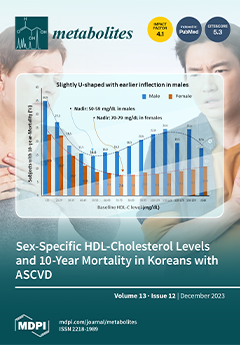In this study, the chemical investigation of
Tetraena aegyptia (Zygophyllaceae) led to the identification of a new megastigmene derivative, tetraenone A ((2
S, 5
R, 6
R, 7
E)-2-hydroxy-5,6-dihydro-β-ionone) (
1), along with (3
S, 5
R
[...] Read more.
In this study, the chemical investigation of
Tetraena aegyptia (Zygophyllaceae) led to the identification of a new megastigmene derivative, tetraenone A ((2
S, 5
R, 6
R, 7
E)-2-hydroxy-5,6-dihydro-β-ionone) (
1), along with (3
S, 5
R, 6
S, 7
E)-3-hydroxy-5,6-epoxy-5,6-dihydro-β-ionone- (
2), 3,4-dihydroxy-cinnamyl alcohol-4-glucoside (
3), 3β,19α-dihydroxy-ursan-28-oic acid (
4), quinovic acid (
5),
p-coumaric acid (
6), and ferulic acid (
7), for the first time. The chemical structures of
1–
7 were confirmed by analysis of their 1D and 2D NMR and HRESIMS spectra and by their comparison with the relevant literature. The absolute configurations of
1 and
2 were assigned based on NOESY interactions and ECD spectra. Conformational analysis showed that
1 existed exclusively in one of the two theoretically possible chair conformers with a predominant
s-trans configuration for the 3-oxobut-1-en-1-yl group with the ring, while the half-chair conformer had a pseudo-axial hydroxy group that was predominant over the other half-chair conformation. Boat conformations were not among the most stable conformations, and the
s-trans isomerism was in favor of
s-cis configuration. In silico investigation revealed that
1 and
2 had more favorable binding interactions with M
pro rather than with TMPRSS2. Accordingly, molecular dynamic simulations were performed on the complexes of compounds
1 and
2 with M
pro to explore the stability of their interaction with the target protein structure. Compounds
1 and
2 might offer a possible starting point for developing covalent inhibitors of M
pro of SARS-CoV-2.
Full article






